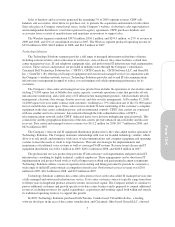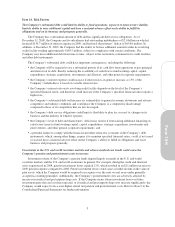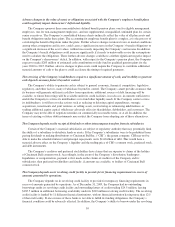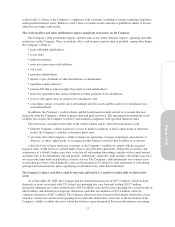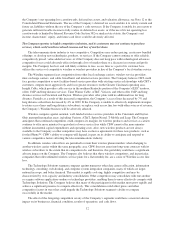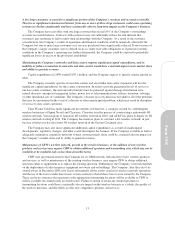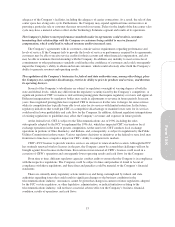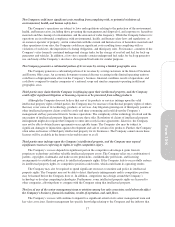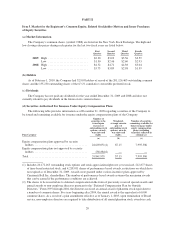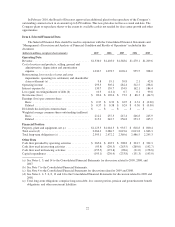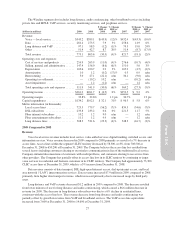Cincinnati Bell 2009 Annual Report Download - page 87
Download and view the complete annual report
Please find page 87 of the 2009 Cincinnati Bell annual report below. You can navigate through the pages in the report by either clicking on the pages listed below, or by using the keyword search tool below to find specific information within the annual report.
The Company could incur significant costs resulting from complying with, or potential violations of,
environmental, health, and human safety laws.
The Company’s operations are subject to laws and regulations relating to the protection of the environment,
health, and human safety, including those governing the management and disposal of, and exposure to, hazardous
materials and the cleanup of contamination, and the emission of radio frequency. While the Company believes its
operations are in substantial compliance with environmental, health, and human safety laws and regulations, as
an owner or operator of property, and in connection with the current and historical use of hazardous materials and
other operations at our sites, the Company could incur significant costs resulting from complying with or
violations of such laws, the imposition of cleanup obligations, and third-party suits. For instance, a number of the
Company’s sites formerly contained underground storage tanks for the storage of used oil and fuel for back-up
generators and vehicles. In addition, a few sites currently contain underground fuel tanks for back-up generator
use, and many of the Company’s sites have aboveground fuel tanks for similar purposes.
The Company generates a substantial portion of its revenue by serving a limited geographic area.
The Company generates a substantial portion of its revenue by serving customers in the Greater Cincinnati
and Dayton, Ohio areas. An economic downturn or natural disaster occurring in this limited operating territory
could have a disproportionate effect on the Company’s business, financial condition, results of operations, and
cash flows compared to similar companies of a national scope and similar companies operating in different
geographic areas.
Third parties may claim that the Company is infringing upon their intellectual property, and the Company
could suffer significant litigation or licensing expenses or be prevented from selling products.
Although the Company does not believe that any of its products or services infringe upon the valid
intellectual property rights of third parties, the Company may be unaware of intellectual property rights of others
that may cover some of its technology, products, or services. Any litigation growing out of third-party patents or
other intellectual property claims could be costly and time-consuming and could divert the Company’s
management and key personnel from its business operations. The complexity of the technology involved and the
uncertainty of intellectual property litigation increase these risks. Resolution of claims of intellectual property
infringement might also require the Company to enter into costly license agreements. Likewise, the Company
may not be able to obtain license agreements on acceptable terms. The Company also may be subject to
significant damages or injunctions against development and sale of certain of its products. Further, the Company
often relies on licenses of third-party intellectual property for its businesses. The Company cannot ensure these
licenses will be available in the future on favorable terms or at all.
Third parties may infringe upon the Company’s intellectual property, and the Company may expend
significant resources enforcing its rights or suffer competitive injury.
The Company’s success depends in significant part on the competitive advantage it gains from its
proprietary technology and other valuable intellectual property assets. The Company relies on a combination of
patents, copyrights, trademarks and trade secrets protections, confidentiality provisions, and licensing
arrangements to establish and protect its intellectual property rights. If the Company fails to successfully enforce
its intellectual property rights, its competitive position could suffer, which could harm its operating results.
The Company may also be required to spend significant resources to monitor and police its intellectual
property rights. The Company may not be able to detect third-party infringements and its competitive position
may be harmed before the Company does so. In addition, competitors may design around the Company’s
technology or develop competing technologies. Furthermore, some intellectual property rights are licensed to
other companies, allowing them to compete with the Company using that intellectual property.
The loss of any of the senior management team or attrition among key sales associates could adversely affect
the Company’s business, financial condition, results of operation, and cash flows.
The Company’s success will continue to depend to a significant extent on its senior management team and
key sales associates. Senior management has specific knowledge relating to the Company and the industry that
17
Form 10-K


